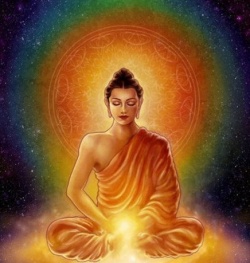Difference between revisions of "Devīcakra"
| Line 1: | Line 1: | ||
{{DisplayImages|{{Random number}}}} | {{DisplayImages|{{Random number}}}} | ||
| + | |||
| + | |||
| + | |||
| + | |||
| Line 11: | Line 15: | ||
It is named after a group of [[female deities]] who are called [[Devīs]] (‘[[goddesses]]’). It is situated in the region below the {{Wiki|navel}} (corresponds to the location of the [[Ādhāra]] and the [[Śvādhiṣṭhāna]] combined). | It is named after a group of [[female deities]] who are called [[Devīs]] (‘[[goddesses]]’). It is situated in the region below the {{Wiki|navel}} (corresponds to the location of the [[Ādhāra]] and the [[Śvādhiṣṭhāna]] combined). | ||
| − | The Devīcakra is made up of those [[elements]] which represent the more substantial or [[phenomenal]] aspects of [[life]]. | + | The [[Devīcakra]] is made up of those [[elements]] which represent the more substantial or [[phenomenal]] aspects of [[life]]. |
Its [[symbolism]] mainly concerns the creation of both [[physical]] [[life]] and the [[Sāṃkhya]] [[phenomenal world]], i.e., the genesis of the [[human]] [[physical body]], as well as the [[metaphysical]] {{Wiki|principles}} which, by means of this [[body]] ,bind the [[ātman]] to its [[worldly existence]]. | Its [[symbolism]] mainly concerns the creation of both [[physical]] [[life]] and the [[Sāṃkhya]] [[phenomenal world]], i.e., the genesis of the [[human]] [[physical body]], as well as the [[metaphysical]] {{Wiki|principles}} which, by means of this [[body]] ,bind the [[ātman]] to its [[worldly existence]]. | ||
| Line 17: | Line 21: | ||
From the centre outwardly evolves a {{Wiki|structure}} of predominantly [[female deities]] who [[symbolize]] different aspects of the [[phenomenal]] and phonic creation. | From the centre outwardly evolves a {{Wiki|structure}} of predominantly [[female deities]] who [[symbolize]] different aspects of the [[phenomenal]] and phonic creation. | ||
| − | In the case of the [[Devicakra]], the Dūtīcakra and the Mātṛcakra, this unfolding takes place in two phases, first a number of [[deities]] come into [[existence]] who divide themselves again into further secondary [[manifestations]]. | + | In the case of the [[Devicakra]], the [[Dūtīcakra]] and the [[Mātṛcakra]], this unfolding takes place in two phases, first a number of [[deities]] come into [[existence]] who divide themselves again into further secondary [[manifestations]]. |
| − | In the Devīcakra there are four main Devīs who are fourfold each; these twenty Devīs together with six (‘{{Wiki|male}}’) categories [[form]] the [[phenomenal]] {{Wiki|principles}} ([[tattvas]]) which limit the [[individual]] [[soul]]. They are linked to speculations on the genesis of the [[human body]]. | + | In the [[Devīcakra]] there are four main [[Devīs]] who are fourfold each; these twenty [[Devīs]] together with six (‘{{Wiki|male}}’) categories [[form]] the [[phenomenal]] {{Wiki|principles}} ([[tattvas]]) which limit the [[individual]] [[soul]]. They are linked to speculations on the genesis of the [[human body]]. |
{{R}} | {{R}} | ||
http://www.wisdomlib.org/definition/dev%C4%ABcakra/index.html | http://www.wisdomlib.org/definition/dev%C4%ABcakra/index.html | ||
{{SanskritTerminology}} | {{SanskritTerminology}} | ||
[[Category:Chakra]] | [[Category:Chakra]] | ||
Latest revision as of 22:52, 3 February 2024
Devīcakra (देवीचक्र):—One of the five internal mystic centres (pañcacakra), according to the kubjikāmata-tantra (or, kādiprakaraṇa). These five cakras follow the general principle of a cakra (inward representation of a maṇḍala, the representation of cosmic creation).
The Devīcakra is associated with the gross element Earth (pṛthvī).
It is named after a group of female deities who are called Devīs (‘goddesses’). It is situated in the region below the navel (corresponds to the location of the Ādhāra and the Śvādhiṣṭhāna combined).
The Devīcakra is made up of those elements which represent the more substantial or phenomenal aspects of life.
Its symbolism mainly concerns the creation of both physical life and the Sāṃkhya phenomenal world, i.e., the genesis of the human physical body, as well as the metaphysical principles which, by means of this body ,bind the ātman to its worldly existence.
From the centre outwardly evolves a structure of predominantly female deities who symbolize different aspects of the phenomenal and phonic creation.
In the case of the Devicakra, the Dūtīcakra and the Mātṛcakra, this unfolding takes place in two phases, first a number of deities come into existence who divide themselves again into further secondary manifestations.
In the Devīcakra there are four main Devīs who are fourfold each; these twenty Devīs together with six (‘male’) categories form the phenomenal principles (tattvas) which limit the individual soul. They are linked to speculations on the genesis of the human body.
Source
http://www.wisdomlib.org/definition/dev%C4%ABcakra/index.html
